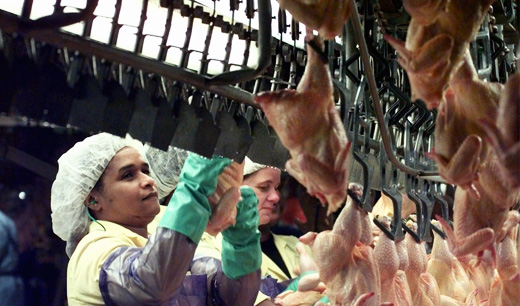
WASHINGTON – A top Hispanic-American civil rights group, the National Council of La Raza, has joined the campaign against an Obama administration Agriculture Department proposal to speed up poultry plant processing lines.
In its statement and in a new study, the council says USDA’s plan to double the line speeds, from 90 chickens per minute to 175, would put poultry workers – one-third of whom are Hispanic – at increased risk of job injury.
The present risk is underreported, the study adds, because many of the workers are afraid or intimidated into not reporting job injuries, fearing employer retaliation. And, citing United Food and Commercial Workers data, it notes only 30 percent of poultry processor workers are unionized.
UFCW and the American Federation of Government Employees have campaigned for months against the new USDA rules. AFGE says an additional hazard of the sped-up lines is that the agency’s Food Safety and Inspection Service inspectors – whom the union represents – would now share chicken inspection responsibility with poultry plant workers and managers.
And those workers and managers, inspectors said walking a picket line in April, would be under pressure to increase profits by cutting corners and letting diseased chickens go by. USDA estimates that doubling the line speed while adding the non-inspectors to policing the lines would save the government $90 million and plant owners $256 million yearly.
La Raza said the cost, however, would be workers’ health.
“Workers on the poultry processing line are assigned specific tasks they repeat at rapid speed for their entire shifts, including slaughtering, sorting, cleaning, inspecting, trimming, cutting, and packaging. Most of this work is performed standing up. As a result, musculoskeletal injuries to the hands, wrists, and arms, including carpal tunnel syndrome, as well as the back, are perceived to be very common,” its report says.
It adds that the reported injury rate in poultry processing is 5.9 injuries per 100 workers. The report did not calculate how many more workers would be injured – or what the rate would be – if line speed doubles.
“In addition to line speed, other hazardous conditions in poultry processing plants contribute to injuries and illnesses for workers. According to Sarah Quandt, a leading expert in qualitative research in health and safety among Latino poultry workers, ‘dampness, animal proteins, contamination from poultry excreta, feathers, and other organic substances, knives, and scissors in crowded conditions are connected to dermatological, respiratory, and other illnesses. A study of North Carolina Latino poultry workers by Quandt and other researchers found 60 percent of them had symptoms of these injuries/illnesses.
“Poultry workers face multiple barriers to reporting injuries and receiving the care that they need,” the La Raza report remarks. “Lack of job security, language barriers, immigration status, and the absence of a union are all factors that prevent many workers from raising concerns with supervisors or inspectors. Latino poultry workers tend to face multiple barriers, since many of them are immigrants who may have limited English proficiency or insecure immigration status.”
Those problems would only get worse if USDA’s proposal goes through, says Eric Rodriguez, a top official at La Raza. Deadline for comments on USDA’s plan was extended to May 29.
“Common sense says if you take a process that is already dangerous and nearly double the speed of production lines, you will increase the risk of injury among poultry workers,” said Rodriguez, vice president of the Office of Research, Advocacy, and Legislation at La Raza.
“It is gravely irresponsible to press ahead with this rule given what we know about the conditions in the poultry industry today. That USDA made no effort to put in place steps for greater oversight and monitoring of safety for companies that increase production speeds is troubling. We expect better from an administration that is committed to protecting vulnerable workers.”
Instead, he said, USDA forged ahead without consulting the Occupational Safety and Health Administration or other agencies on the impact of the proposal on workers.
“USDA’s proposed rule is based on the unsubstantiated assumption that faster line speed will have no adverse impact on worker health and safety,” the council’s study adds. “The fact that USDA fails to account for the costs to worker health and safety in its justification of the proposed rule violates the requirements to conduct a comprehensive analysis of the costs and benefits of new regulations.”
“USDA should rescind this rule and work with other federal agencies to develop a comprehensive plan to mitigate hazards and protect poultry workers,” Rodriguez concluded.
Photo: On the assembly lines at a poultry processing plant, poultry workers prepare cleaned and gutted chickens for packaging. J. Scott Applewhite/AP









